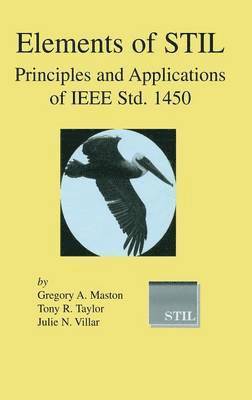
- Format
- Inbunden (Hardback)
- Språk
- Engelska
- Antal sidor
- 291
- Utgivningsdatum
- 2003-10-01
- Upplaga
- 2003 ed.
- Förlag
- Springer-Verlag New York Inc.
- Medarbetare
- Taylor, Tony R. / Villar, Julie N.
- Illustrationer
- XIX, 291 p.
- Dimensioner
- 240 x 160 x 27 mm
- Vikt
- Antal komponenter
- 1
- Komponenter
- 1 Hardback
- ISBN
- 9781402076374
- 690 g
Elements of STIL
Principles and Applications of IEEE Std. 1450
- Skickas från oss inom 7-10 vardagar.
- Fri frakt över 249 kr för privatkunder i Sverige.
Passar bra ihop
De som köpt den här boken har ofta också köpt Meriam's Engineering Mechanics av James L Meriam, L G Kraige, J N Bolton (häftad).
Köp båda 2 för 2412 krKundrecensioner
Innehållsförteckning
1 Foundations of STIL.- 1.1 Introduction.- 1.2 Organization of this Book.- 1.3 History.- 1.4 Foundation Efforts.- 1.5 Scope of STIL and Follow-On Efforts.- 1.6 Parallel Standards.- 2 STIL Test.- 2.1 Test Stresses.- 2.2 Test Strategies.- 2.3 Test Behaviors.- 2.4 Test Induced Faults.- 2.5 Other Applications of STIL.- 3 Signals.- 3.1 Signals.- 3.2 Signal Arrays.- 3.3 SignalGroups.- 3.4 STIL Statement Constructs and Block Structure.- 3.5 Signals and SignalGroups Syntax.- 3.6 Signal and SignalGroup Attributes.- 3.7 The Test Attributes.- 3.8 WGL Signals.- 4 Timing.- 4.1 The Timing Block.- 4.2 Event Statements.- 4.3 Basic Time Expressions.- 4.4 Waveforms.- 4.5 WaveformCharacters.- 4.6 Merging Common Waveforms.- 4.7 Event Ordering and Persistence.- 4.8 Maintaining Related Events.- 4.9 Special Events.- 4.10 The Rest of the Timing Block Syntax.- 4.11 WGL Timing Constructs.- 5 Patterns.- 5.1 Fundamental Pattern Constructs.- 5.2 Statement Order Dependency.- 5.3 WaveformTable Reference Statement.- 5.4 Signal Assignment.- 5.5 Vectors.- 5.6 Conditions.- 5.7 Incremental Behavior.- 5.8 Loop Constructs.- 5.9 Labels.- 5.10 Stop and IDDQTestPoint.- 5.11 Breakpoint.- 5.12 WGL Pattern Constructs.- 6 Tying It All Together.- 6.1 Basic STIL Information Flow.- 6.2 The PatternBurst.- 6.3 The PatternExec.- 6.4 Additional STIL Constructs.- 6.5 STIL Block Order.- 6.6 WGL Constructs.- 7 Files and the Include Statement.- 7.1 Include Statement.- 7.2 The IfNeed Option.- 7.3 Additional File Constructs and Behaviors.- 8 Specifications.- 8.1 Device Operating Specifications.- 8.2 STIL Extensions to the Spec Variables.- 8.3 Spec and Category.- 8.4 Spec Variable Resolution.- 8.5 Based Expressions.- 8.6 Selector.- 8.7 Applying Spec Variables.- 8.8 More Spec Constructs.- 8.9 Relative Waveform Timing.- 8.10 Styles of Timing Representation.- 8.11 WGL Specification Constructs.- 9 Partitioning Timing.- 9.1 All-Waveforms-in-One-Table.- 9.2 One-Waveform-Per-Table.- 9.3 Happier Mediums.- 9.4 Waveform Grouping/Merging.- 9.5 WGL Pattern Data and WaveformCharacters.- 10 Advanced Timing.- 10.1 Incremental Timing Definitions.- 10.2 Inherit Strategies.- 10.3 SubWaveforms.- 10.4 Multiple Data Waveforms.- 11 Procedures and Macros.- 11.1 Structured Test Development.- 11.2 STIL Procedures.- 11.3 MacroDefs.- 11.4 Differences Between Procedures and Macros.- 11.5 Procedure and Macro Parameters.- 11.6 Calling Procedures and Macros.- 11.7 Using Named Procedures/MacroDefs Blocks.- 11.8 WGL Procedures and Macros.- 12 STIL Scan.- 12.1 Scan Design.- 12.2 STIL Scan Constructs.- 12.3 Scan Data Alignment (Scan Padding).- 12.4 More Considerations on Scan Constructs.- 12.5 Scan Groups.- 12.6 An Example: Transition Testing.- 12.7 WGL Scan.- 13 STIL Levels.- 13.1 STIL Statement with Extensions.- 13.2 Static and Dynamic Levels.- 13.3 Static Levels.- 13.4 Inter-cycle Dynamic Levels.- 13.5 Intra-cycle Dynamic Levels.- 13.6 DCSequence.- 13.7 Inherit Constructs.- 13.8 STIL Blocks and Data.- 14 More Pattern Constructs.- 14.1 Event-based Pattern Data.- 15 User Extensions.- 15.1 UserKeywords statement.- 15.2 Ambiguous Scenarios.- 15.3 UserFunctions.- 16 Additional Test Considerations.- 16.1 The Concept of Test Constraints.- 17 Name Mapping.- 17.1 Signal Names.- Terminology.- STIL Syntax Summary.
Du kanske gillar
-
Calculus
Robert A Adams
Inbunden


